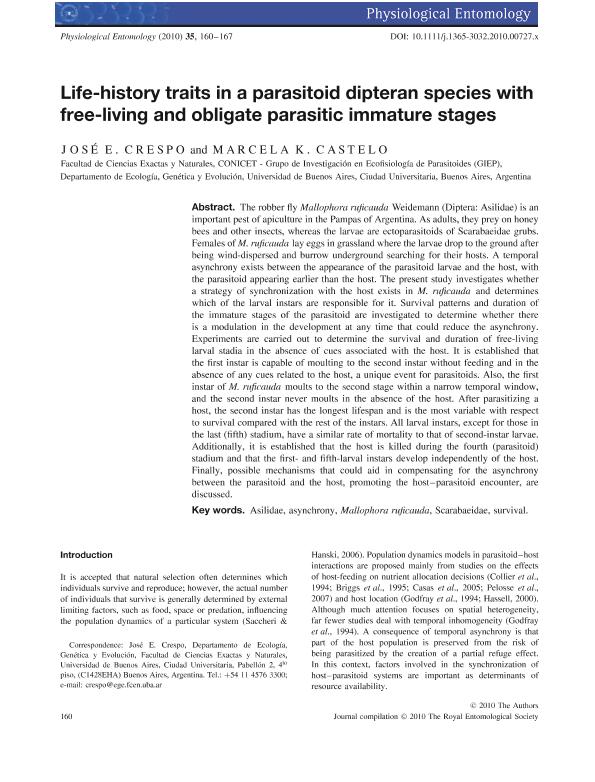Mostrar el registro sencillo del ítem
dc.contributor.author
Crespo, José Emilio

dc.contributor.author
Castelo, Marcela Karina

dc.date.available
2019-01-15T18:26:56Z
dc.date.issued
2010-06
dc.identifier.citation
Crespo, José Emilio; Castelo, Marcela Karina; Life-history traits in a parasitoid dipteran species with free-living and obligate parasitic immature stages; Wiley Blackwell Publishing, Inc; Physiological Entomology (print); 35; 2; 6-2010; 160-167
dc.identifier.issn
0307-6962
dc.identifier.uri
http://hdl.handle.net/11336/68056
dc.description.abstract
The robber fly Mallophora ruficauda Weidemann (Diptera: Asilidae) is an important pest of apiculture in the Pampas of Argentina. As adults, they prey on honey bees and other insects, whereas the larvae are ectoparasitoids of Scarabaeidae grubs. Females of M. ruficauda lay eggs in grassland where the larvae drop to the ground after being wind-dispersed and burrow underground searching for their hosts. A temporal asynchrony exists between the appearance of the parasitoid larvae and the host, with the parasitoid appearing earlier than the host. The present study investigates whether a strategy of synchronization with the host exists in M. ruficauda and determines which of the larval instars are responsible for it. Survival patterns and duration of the immature stages of the parasitoid are investigated to determine whether there is a modulation in the development at any time that could reduce the asynchrony. Experiments are carried out to determine the survival and duration of free-living larval stadia in the absence of cues associated with the host. It is established that the first instar is capable of moulting to the second instar without feeding and in the absence of any cues related to the host, a unique event for parasitoids. Also, the first instar of M. ruficauda moults to the second stage within a narrow temporal window, and the second instar never moults in the absence of the host. After parasitizing a host, the second instar has the longest lifespan and is the most variable with respect to survival compared with the rest of the instars. All larval instars, except for those in the last (fifth) stadium, have a similar rate of mortality to that of second-instar larvae. Additionally, it is established that the host is killed during the fourth (parasitoid) stadium and that the first- and fifth-larval instars develop independently of the host. Finally, possible mechanisms that could aid in compensating for the asynchrony between the parasitoid and the host, promoting the host-parasitoid encounter, are discussed.
dc.format
application/pdf
dc.language.iso
eng
dc.publisher
Wiley Blackwell Publishing, Inc

dc.rights
info:eu-repo/semantics/openAccess
dc.rights.uri
https://creativecommons.org/licenses/by-nc-sa/2.5/ar/
dc.subject
Asilidae
dc.subject
Asynchrony
dc.subject
Mallophora Ruficauda
dc.subject
Scarabaeidae
dc.subject
Survival
dc.subject.classification
Otras Ciencias Biológicas

dc.subject.classification
Ciencias Biológicas

dc.subject.classification
CIENCIAS NATURALES Y EXACTAS

dc.title
Life-history traits in a parasitoid dipteran species with free-living and obligate parasitic immature stages
dc.type
info:eu-repo/semantics/article
dc.type
info:ar-repo/semantics/artículo
dc.type
info:eu-repo/semantics/publishedVersion
dc.date.updated
2019-01-14T18:35:56Z
dc.journal.volume
35
dc.journal.number
2
dc.journal.pagination
160-167
dc.journal.pais
Reino Unido

dc.journal.ciudad
Londres
dc.description.fil
Fil: Crespo, José Emilio. Universidad de Buenos Aires. Facultad de Ciencias Exactas y Naturales. Departamento de Ecología, Genética y Evolución; Argentina. Consejo Nacional de Investigaciones Científicas y Técnicas; Argentina
dc.description.fil
Fil: Castelo, Marcela Karina. Universidad de Buenos Aires. Facultad de Ciencias Exactas y Naturales. Departamento de Ecología, Genética y Evolución; Argentina. Consejo Nacional de Investigaciones Científicas y Técnicas; Argentina
dc.journal.title
Physiological Entomology (print)

dc.relation.alternativeid
info:eu-repo/semantics/altIdentifier/doi/http://dx.doi.org/10.1111/j.1365-3032.2010.00727.x
dc.relation.alternativeid
info:eu-repo/semantics/altIdentifier/url/https://onlinelibrary.wiley.com/doi/abs/10.1111/j.1365-3032.2010.00727.x
Archivos asociados
